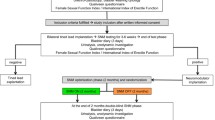Abstract
Purpose of review
Sacral neuromodulation (SNM) is an approved treatment in adults. Despite multiple publications about its safety and efficacy in children, SNM has yet to be approved by the Food and Drug Administration for use in this population. We aim to review all the published literature on SNM in children.
Recent findings
A PUBMED® and MEDLINE® search was performed for scientific publications on “sacral neuromodulation” and “sacral nerve stimulation” in pediatric patients. A total of ten unique articles published between 2006 and 2016 were identified. Each of these publications was thoroughly reviewed and the results included in this article. Refractory bowel and bladder dysfunction (BBD) is the primary indication for SNM placement. The S3 nerve root is the most common anatomical location for lead placement and it is most commonly placed in two stages. The first stage is followed by a trial period to assess symptomatic improvement prior to the second stage when the implantable pulse generator is placed. Symptom improvement ranges across studies but generally improvement or resolution is seen in 60–90 % of patients when properly selected. Potential complications include infection, lead breakage or migration, pain at the insertion site, device erosion, and device failure. Such complications are rare and SNM placement is generally accepted as successful and safe.
Summary
Sacral neuromodulation is an effective intervention for refractory bowel and bladder dysfunction in the carefully selected child. This technology is not approved for use in children younger than 16 in the United States, but as the body of literature grows, it is feasible that its application in the pediatric population will become more widely accepted.
Similar content being viewed by others
References
Papers of particular interest, published recently, have been highlighted as: • Of importance •• Of major importance
Humphreys MR, Vandersteen DR, Slezak JM, Hollatz P, Smith CA, Smith JE, et al. Preliminary results of sacral neuromodulation in 23 children. J Urol. 2006;176:2227–31.
Roth RJ, Vandersteen DR, Hollatz P, Inman BA, Reinberg YE. Sacral neuromodulation for the dysfunctional elimination syndrome: a single center experience with 20 children. J Urol. 2008;180:306–11.
Haddad M, Vesson R, Aubert D, Ravasse P, Lemelle J, El Ghoneimi A, et al. Sacral neuromodulation in children with urinary and fecal incontinence: a multicenter, open label, randomized, crossover study. J Urol. 2010;184:696–701.
van Wunnik BP, Peeters B, GOvaert B, Nieman FH, Benninga MA, Baeten CG. Sacral neuromodulation therapy: a promising treatment for adolescents with refractory functional constipation. Dis Colon Rectum. 2012;55:278–86.
Groen L-A, Hoebeke P, Loret N, Van Praet C, Laecke EV, Ann R, et al. Sacral neuromodulation with an implantable pulse generator in children with lower urinary tract symtoms: 15-year experience. J Urol. 2012;188:1313–8.
Stephany HA, Juliano TM, Clayton DB, Tanaka ST, Thomas JC, Adams MC, et al. Prospective evaluation of sacral nerve modulation in children with validated questionnaires. J Urol. 2013;190:1516–22.
Dwyer ME, Vandersteen DR, Hollatz P, Reinberg YE. Sacral neuromodulation for the dysfunctional elimination syndrome: a 10-year single-center experience with 105 consecutive children. Urology. 2014;84:911–7. The largest study with long-term followup of sacral neuromodulation as a treatment for bladder dysfunction in children.
Sulkowski JP, Nacion KM, Deans KJ, Minneci PC, Levitt MA, Mousa HM, et al. Sacral nerve stimulation: a promising therapy for fecal and urinary incontinence and constipation in children. J Pediatr Surg. 2015;50:1644–7.
Schober MS, Sulkowski JP, Lu PL, Minneci PC, Deans KJ, Teich S, et al. Sacral nerve stimulation for pediatric lower urinary tract dysfunction: development of standardized pathway with objective urodynamic outcomes. J Urol. 2015;194:1721–7. Proposes a treatment protocol for the use of sacral neuromodulation as a valid therapy for refractory pediatric BBD.
Mason MD, Stephany HA, Casella DP, Clayton DB, Tanaka ST, Thomas JC, et al. Prospective evaluation of sacral neuromodulation in children: outcomes and urodynamic predictors of success. J Urol. 2016;195:1239–44. Reviews the results of preoperative udrodynamics and body mass index as factors predicting success and complications of sacral neuromodulation in children.
Rawashdeh YF, Siggaard AC, Bauer SB, Franco I, de Jong TP, Jorgensen TM, et al. International children’s continence society’s recommendations for therapeutic intervention in congenital neuropathic bladder and bowel dysfunction in children. Neurourol Urodyn. 2012;31:615–20.
dos Santos J, Varghese A, Williams K, Koyle MA. Recommendations for the management of bladder bowel dysfunction in children. Pediatr Ther. 2014;4:1–11.
Austin PF, Bauer S, Bower W, Chase J, Franco I, Hoebeke P, et al. The standardization of terminology of bladder function in children and adolescents: update report from the standardization committee of the international children’s continence society (ICCS). Neurourol Urodyn. 2016;35:471–8.
Bartley J, Gilleran J, Peters K. Neuromodulation for overactive bladder. Urology. 2013;10:513–21.
Clark C, Ngo T, Comiter CV, Anderson R, Kennedy W. Sacral nerve stimulator revision due to somatic growth. J Urol. 2011;186:1576–80.
Guys JM, Haddad M, Planche D, Torre M, Louis-BOrrione C, Breaud J. Sacral neuromodulation for neurogenic bladder dysfunction in children. J Urol. 2004;172:1673–6.
Schober MS, Ching CB, Peters KM, Alpert SA. Novel use of pudendal neuromodulation in a pediatric patient with caudal regression and partial sacral agenesis for refractory bowel bladder dysfunction. Urology. 2016.
Author information
Authors and Affiliations
Corresponding author
Ethics declarations
Conflict of Interest
Drs. Fuchs & Alpert declare no conflict of interest.
Human and Animal Rights and Informed Consent
This article does not contain studies with human or animal subjects performed by the author.
Additional information
This article is part of the Topical Collection on Pediatric Bladder Dysfunction
Rights and permissions
About this article
Cite this article
Fuchs, M.E., Alpert, S.A. Sacral Neuromodulation for Bladder Dysfunction in Children: Indications, Results and Complications. Curr Bladder Dysfunct Rep 11, 195–200 (2016). https://doi.org/10.1007/s11884-016-0377-0
Published:
Issue Date:
DOI: https://doi.org/10.1007/s11884-016-0377-0




